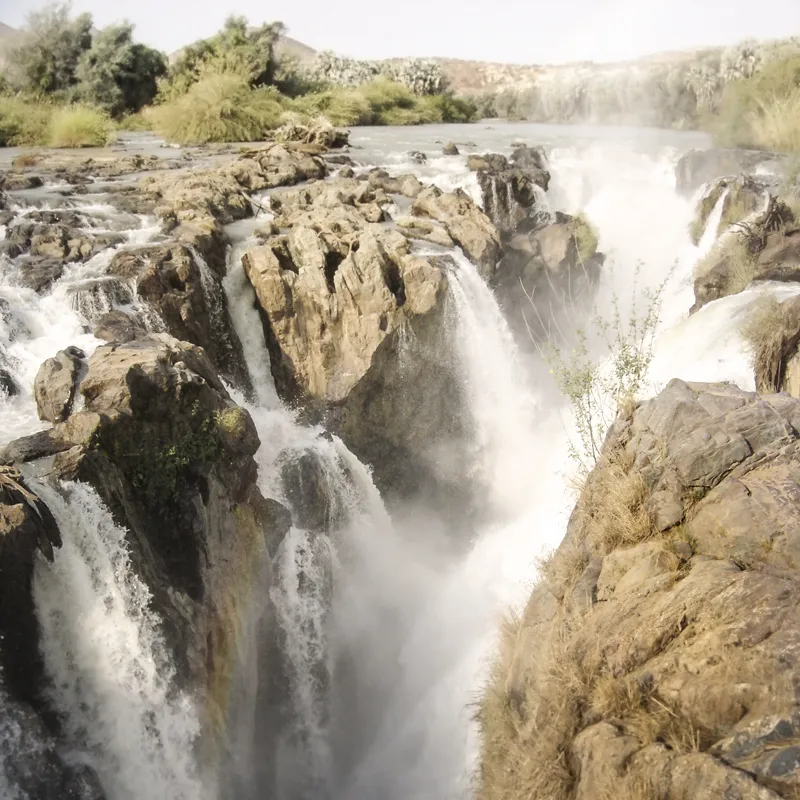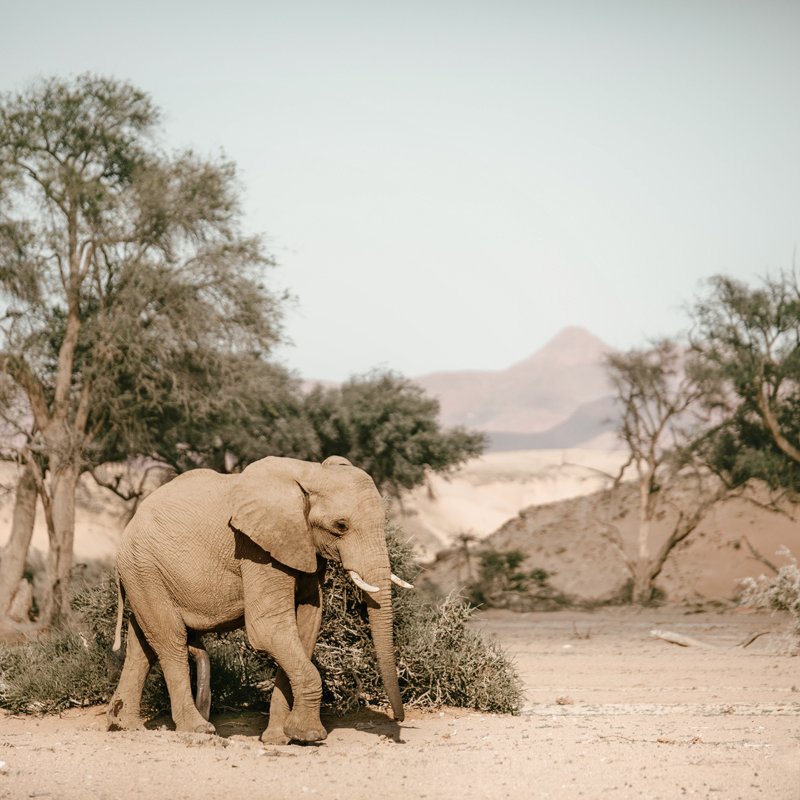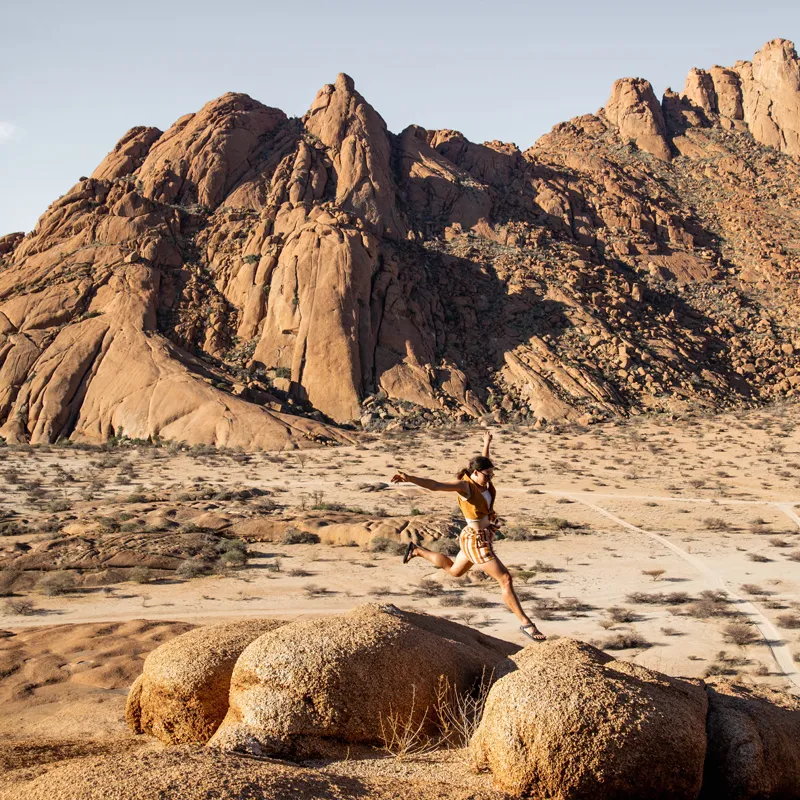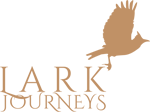North-West Namibian Adventure
Private Guided Safari
At A Glance
TOUR TYPE
DURATION
COST
This 16-day camping adventure explores northwest Namibia, also known as the Kunene Region (formerly Kaokoland), one of the country’s most unexplored areas boasting an abundance of desert-adapted wildlife, cultural diversity and ever-changing landscapes, enough to blow the mind.
From Windhoek, the first stop is Etosha National Park, one of Southern Africa’s premier game reserves and famed for its incredible wildlife sightings. Spend 2 nights camping at Okaukuejo, where big game including elephant, rhino, lion, leopard, giraffe and more enjoying the floodlit waterhole well into the evening.
In stark contrast to Etosha, the next destination is the Kunene River, one of Namibia’s few perennial rivers and hope to a seemingly tropical paradise with Makalani palms lining the river and the thundering drop of Epupa Falls just a short walk away. Enjoy a full day exploring this incredible area, meeting the local Himba tribe, and an optional river cruise to see the area from a different perspective.
From Epupa, spend 1 night in Opuwo, the capital of Kaokoland, before heading west into the ‘desert’. Here, landscapes are ever-changing from rocky mountain passes to dry river crossings to floodplains scattered with roaming cattle, desert-dwelling wildlife and on occasion, a remote Himba village. From here, spend the next week exploring the ephemeral river beds of the Khumib, Hoarusib and Hoanib, where desert-adapted elephant, giraffe and lion roam and birds from hornbills to vultures to bee-eaters nest in the trees providing the landscape’s natural soundtrack.
The chance to spot Namibia’s desert-adapted wildlife is one not to miss. Desert adapted elephant can be found in just 2 countries globally, Namibia and Mali, and their special adaptations allow them to go long periods without water which, in comparison to their Etosha cousins, who need around 100L of water per day to survive, is an impressive feat.
This area is also home to the desert-dwelling Angolan giraffe and one of the worlds most successful conservation stories thanks to long term ongoing research by the Giraffe Conservation Foundation. Here the population of free-roaming giraffe continues to grow, highlighting the region and community conservation success.
From the ephemeral rivers in the Kunene Region, the next stop is the Palmwag Concession. The landscape changes from sandy riverbeds to basalt rocks and Euphorbia Damarana as far as the eye can see. Here Namibia’s black rhino population continues to thrive under the watchful eye of conservationists like the Save The Rhino Trust.
With just 1 last stop of the way back to Windhoek, we make our way through Southern Damaraland, visit Twyfelfontein and meeting the local Damara people before arriving at Spitzkoppe, Namibia’s Matterhorn, a collection of impressive granite peaks that seemingly rise from nowhere. This area is a hiker’s and photographers paradise!
For those looking to get off the beaten track but avoid the camping adventure, why not consider a fly-in safari exploring Northwest Namibia and staying at some of countries premier lodges, known for their incredible locations and spectacular experiences.
Highlights
Day-by-Day Itinerary
On arrival at Windhoek International Airport, we will meet our guide and make our way into Windhoek. Depending on our arrival, there may be time for an afternoon City & Township Tour before sunset. Windhoek city itself is quite small, so should we wish to explore on foot with our guide, this is also possible before dinner.
Activities: Airport pick up
Optional Activities: City & Township Tour
Accommodation: Windhoek Luxury Suites
We depart Windhoek this morning after breakfast, no later than 9h00, as we head north through Okahandja, Otjiwarongo and on to Etosha National Park, one of Southern Africa’s premier game reserves, home to some 340 species of birds, mammals, reptiles and even 1 species of fish. On arrival at the park gate, we game drive through to Okaukuejo, where we spend the next 2 nights. After setting up camp and having lunch, we head out for a late afternoon game drive, stopping at waterhole after waterhole to see what we can find before returning to camp just before sunset.
Activities: Afternoon game drive in Etosha National Park
Optional Activities: Night drive in Etosha National park
Accommodation: Okaukuejo Campsite
Meals: Breakfast, Lunch, Dinner
Today, a full day to explore Etosha National Park, to game drive either morning & afternoon, or head out across the park for a full day, visit the famous Etosha Pan (where the park gets its name). Etosha National Park stretches some 22,000km², and the pan is so big it can be seen from space. Photography opportunities around Etosha’s waterholes can be some of southern Africa’s best. Due to a lack of natural waterholes and rivers, wildlife congregates together, and the chance to capture both prey & predators around the waterhole together is not uncommon. In addition to this, Okaukuejo offers excellent floodlit waterholes at the camp so we can enjoy the chance to watch the animals well into the night if we wish.
Activities: Full day game drive inside Etosha National Park
Optional Activities: Night drive in Etosha National park
Accommodation: Okaukuejo Campsite
Meals: Breakfast, Lunch, Dinner
Today’s drive takes us through the lesser travelled part of Etosha. Game viewing in this part of the park can be exceptional, and the chance to spot some species that can’t be seen in other parts of Etosha, such as Hartmann’s Mountain Zebra. Stopping for a picnic lunch at Olifantsrus, we can enjoy a visit to the double story hide and a walk through the information centre before exiting the park and entering the adjacent Hobatere Concession. On arrival at Hobatere, we can check-in and unwind with a drink before enjoying dinner and an optional evening game drive in search of predators.
Activities: Full day game drive across Etosha National Park
Optional Activities: Night drive in Hobatere Concession
Accommodation: Hobatere Lodge
Meals: Breakfast, Lunch, Dinner
Today we can enjoy a leisurely breakfast before hitting the road and heading north all the way through to the Angolan border and the Epupa Falls. We make our way through Opuwo and will see many small villages scattered along the road. We have the chance to stop and meet the local people as we go. On arrival at Epupa, we can set up camp and take a short walk to witness the Epupa Falls. This area is a welcome oasis amidst the desert, with one of the country’s few perennial rivers providing constant nourishment for the surrounding people, flora and fauna. Enjoy the stunning scenery with enormous Makalani Palms and Baobab Trees, Himba people and hundreds of thousands of cubic meters of water cascading over the falls.
Accommodation: Epupa Falls Campsite
Meals: Breakfast, Lunch, Dinner
Today we have a full day to explore the Epupa area to get to know the local people. We spend the morning visiting a local Himba village. The Himba people are one of Namibia’s most iconic tribal groups, with some of the most intriguing customs of all the tribal groups. The women are the easiest to recognize with their striking red skin, made with a combination of ochre and butterfat, used as a natural sun-cream against the harsh Namibian rays. Spend the morning getting to know more about their ancient traditions and customs. The afternoon is spent at leisure, some free time to relax or explore.
Activities: Guided Himba village visit
Accommodation: Epupa Falls Campsite
Meals: Breakfast, Lunch, Dinner
A leisurely start this morning as we pack up camp and make the short journey south back to Opuwo. This is the capital of the Kunene Region, and here we will experience the true mixing pot of cultures that is typical of all ‘capital’ cities. Here the OvaHimba and the OtjiHerero roam the town scattered with the smaller and lesser-known tribal groups of the Ovazemba, the Ovatjimba, the Ovatwa. This afternoon is our last chance to grab some fresh supplies before we head west so we do a little grocery shopping before enjoying the afternoon by the pool and the chance to pamper ourselves with the relative comforts of staying in accommodation.
Accommodation: Opuwo Country Lodge
Meals: Breakfast
After breakfast, we hit the road this morning, heading west into the relatively undiscovered territory of the northwest. Today’s drive is one of the most scenic, with ever-changing landscapes from floodplains to river crossings to winding and rugged mountain roads. This is also our first chance to glimpse some of the area’s desert-adapted wildlife as we make our way meandering along the Hoarusib River. We aim to arrive at Marble Camp mid-afternoon, where we can take a short walk to explore the area and enjoy a spectacular sunset from the top of the hill.
Activities: Scenic drive to camp
Accommodation: Marble Camp
Meals: Breakfast, Lunch, Dinner
After breakfast, we pack up camp and head south (and west), meandering along the Khumib River. This area is home to a healthy population of desert-adapted Angolan giraffe, and so as we make our way along the river, we should keep an eye out for these gentle giants. This area is also home to several Himba villages, and so it’s not unusual to spot a person wandering across the desert, seemingly lost, whilst they tend their livestock. We continue down the Khumib River and travel almost to the border of the Skeleton Coast National Park. Using GPS coordinates, we meander south along the border through the dune field and enjoy how much the landscape has changed from the riverbed. This area offers some of the most breathtaking views, so we are sure to stop, enjoy a picnic lunch and take it all in before arriving at the bustling outpost of Purros, where we spend the night on the banks of the Hoarusib River.
Activities: Scenic drive to camp
Accommodation: Omenye Community Camp
Meals: Breakfast, Lunch, Dinner
On waking this morning, we are sure to check out the tracks around camp as this area is a popular thoroughfare for elephant, giraffe and lion. After a leisurely breakfast and a hot shower, we can start the day with a drive out along the Hoarusib River in search of desert-adapted elephant. These elephants wander the lengths of the dry river beds searching for food and the occasional pool of water in the sand and are often seen even wandering through the village. This afternoon offers the chance to relax at camp, catch up on some camp duties, try out some photography as the giraffe wander by and prepare for tomorrow’s drive further south.
Activities: Scenic drive
Accommodation: Omenye Community Camp
Meals: Breakfast, Lunch, Dinner
Heading south this morning, we cross the Ganais Plains and keeping our open for Hartmans Mountain zebra, giraffe, oryx, steenbok, vultures, and maybe even the black rhino. The terrain along this route varies from open grass plains to rocky river crossing to sandy riverbeds. On arrival at the Hoanib River, we have the chance to stop for a picnic lunch before meandering our way east along the dry riverbed in search of desert elephant, lion, and more. Arriving mid-afternoon at Elephant Song, we set up camp and settle in for another night under the stars, listening for lions roaring and hyenas whooping long into the night.
Activities: Scenic drives
Accommodation: Elephant Song Camp
Meals: Breakfast, Lunch, Dinner
Meals: Breakfast, Lunch, Dinner
We pack up camp this morning and make our way out of the Hoanib, passing through small villages as we make our way to Sesfontein. From here, we make our way through to the Ongongo Falls, where we have the chance to freshen up with a dip in the freshwater spring. After a picnic lunch, we continue to Palmwag Lodge, where we can enjoy the luxury of a bed, a restaurant meal and the option to relax by the pool whilst keeping an eye out for Jimbo, the resident desert elephant that likes to wander through the lodge area.
Activities: Scenic drive & visit to Ongongo Falls
Accommodation: Palmwag Lodge
Meals: Breakfast, Lunch, Dinner
After breakfast this morning, we hit the road and head south. Today, our first stop is at Twyfelfontein, Namibia’s first UNESCO World Heritage site as the home of the world’s largest collections of petroglyphs. These San rock etchings number in the thousands, date back thousands of years, and show how the San people communicated and recorded their experiences. After a short guided tour, we continue south along the C35, where we have the chance to stop and visit the market stalls set up by the local Damara, Herero and Himba women to see their crafts. Stopping for lunch in Uis, we set off mid-afternoon, heading to Spitzkoppe, Namibia’s Matterhorn and one of the most iconic landscapes, a photographer’s paradise. Set up camp on arrival and make our way through to the famed ‘bridge’, one of the most unique and iconic rock formations where we can enjoy our last sunset in the wilderness.
Activities: Guided tour at Twyfelfontein
Accommodation: Spitzkoppe Community Camp
Meals: Breakfast, Dinner
A relaxing start this morning before we pack up camp and explore the Spitzkoppe a little, grabbing a local guide and learning about the ancient San paintings and how they differ from the etchings at Twyfelfontein. We depart Spitzkoppe mid-morning and start our journey back to Windhoek. Our last night is spent in the comfort of a private room, the chance to wash off the dust of the Kunene Region and enjoy a good night’s sleep.
Activities: Guided tour of Small Bushman’s Paradise
Accommodation: Windhoek Luxury Suites
Meals: Breakfast
Today marks the final day of our Namibian experience. Time permitting, enjoy the chance to explore downtown Windhoek before being transferred to Windhoek International Airport in time for our onward flight. End of services.
Activities: Airport drop off
Meals: Breakfast

INCLUDES
Camping
Activities as per itinerary
Guide
Meals as per itinerary
National park entry fees
Transport
Water
EXCLUDES
Drinks
International Flights
Items of personal nature
Optional Activities
Personal travel insurance
Rates
| Minimum People |
|---|




